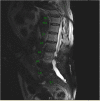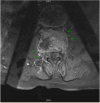Listeria spondylodiscitis: an uncommon etiology of a common condition; a case report
- PMID: 32736610
- PMCID: PMC7395412
- DOI: 10.1186/s12879-020-05286-y
Listeria spondylodiscitis: an uncommon etiology of a common condition; a case report
Abstract
Background: Listeriosis is a severe food-borne infection caused by the Gram-positive rod, Listeria monocytogenes. Despite the low incidence (3-8 cases per million), Listeriosis has a case fatality rate of 20-30% as it occurs predominantly in immunocompromised individuals at extremes of age, diabetics and pregnant women. Listeriosis classically presents as a febrile gastroenteritis, isolated bacteremia, meningitis, or maternal-fetal infections. Focal bone and joint infection are rare and primarily involve orthopedic implant devices. Here, we present the first case of Listeria-associated spondylodiscitis.
Case presentation: A 79-year-old male presents with acute-on-chronic back pain in the absence of risk factors or exposures, aside from age. On radiological imaging, spondylodiscitis of L3-L4 was diagnosed. Subsequently, a CT-guided biopsy was performed to aid in confirming microbiological aetiology. Listeria monocytogenes was grown in culture and patient received appropriate antibacterial therapy.
Conclusion: The case highlights the utility of image-guided tissue sampling in aiding diagnosis and management in patients with vertebral osteomyelitis. It also encourages consideration of uncommon organisms such as Listeria as an etiology of vertebral osteomyelitis, even in the absence of prosthetic implants.
Keywords: Bone & joint infection; Case report; Listeria; Listeriosis; Spondylodiscitis.
Conflict of interest statement
The authors declare that they have no competing interests.
Figures


Similar articles
-
Uncommon manifestations of Listeria monocytogenes infection.BMC Infect Dis. 2014 Dec 3;14:641. doi: 10.1186/s12879-014-0641-x. BMC Infect Dis. 2014. PMID: 25466213 Free PMC article.
-
Spondylodiscitis After Endovascular Aortic Repair Due to Noninvasive Listeriosis: A Case Report.JBJS Case Connect. 2021 Sep 13;11(3). doi: 10.2106/JBJS.CC.21.00212. JBJS Case Connect. 2021. PMID: 34516457
-
[On two cases of systemic listeriosis without dominant neurological compromise].Medicina (B Aires). 2024;84(4):746-749. Medicina (B Aires). 2024. PMID: 39172575 Spanish.
-
Epidemiology and treatment of the commonest form of listeriosis: meningitis and bacteraemia.Infez Med. 2017 Sep 1;25(3):210-216. Infez Med. 2017. PMID: 28956537 Review.
-
Peritonitis as the First Presentation of Disseminated Listeriosis in a Patient on Peritoneal Dialysis-a Case Report.Perit Dial Int. 2017 Mar-Apr;37(2):239-240. doi: 10.3747/pdi.2016.00205. Perit Dial Int. 2017. PMID: 28360372 Review.
Cited by
-
Successful Treatment of Spondylodiscitis and Infectious Sacroiliitis due to Listeria monocytogenes using Meropenem as Salvage Therapy.Eur J Case Rep Intern Med. 2022 Mar 11;9(3):003177. doi: 10.12890/2022_003177. eCollection 2022. Eur J Case Rep Intern Med. 2022. PMID: 35402343 Free PMC article.
-
Listeria endocarditis and spondylodiscitis: A case report and review of the literature.Clin Case Rep. 2022 May 20;10(5):e05899. doi: 10.1002/ccr3.5899. eCollection 2022 May. Clin Case Rep. 2022. PMID: 35600023 Free PMC article.
-
Clinical Findings of Listeria monocytogenes Infections with a Special Focus on Bone Localizations.Microorganisms. 2024 Jan 16;12(1):178. doi: 10.3390/microorganisms12010178. Microorganisms. 2024. PMID: 38258004 Free PMC article. Review.
-
Vertebral osteomyelitis and epidural abscess due to Listeria monocytogenes - case report and review of literature.J Bone Jt Infect. 2022 Apr 13;7(2):75-79. doi: 10.5194/jbji-7-75-2022. eCollection 2022. J Bone Jt Infect. 2022. PMID: 35464149 Free PMC article.
-
Listeria monocytogenes Ankle Osteomyelitis in a Patient with Rheumatoid Arthritis on Adalimumab: A Report and Literature Review of Listeria monocytogenes Osteomyelitis.Intern Med. 2021;60(19):3171-3176. doi: 10.2169/internalmedicine.5633-20. Epub 2021 Oct 1. Intern Med. 2021. PMID: 34602523 Free PMC article. Review.
References
-
- CDC . National Center for Emerging and Zoonotic Infectious Diseases. National Enteric Disease Surveillance:The Listeria Initiative. 2016. pp. 1–2.
Publication types
MeSH terms
Substances
LinkOut - more resources
Full Text Sources
Medical

